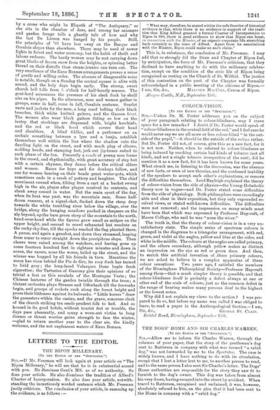COLOUR-VISION.
LEO THE EDITOR 07 THE " SPECTATOR." J
SIR,—Unless Dr. M. Foster addresses you on the subject of your paragraph relating to colour-blindness, may I crave space for a few remarks P I doubt if Dr. Foster would speak of "colour-blindness in the central field of the red," and I feel sure he would never say we are all more or less colour-blind "in the out- side of the pupil,"—it should be the outside of the retina rather. But Dr. Foster did not, of course, give this as a new fact, for it is not new. Neither, when he referred to colour-blindness as being induced by smoking certain bad kinds of tobacco (not all kinds, and not a single tobacco irrespective of the sort), did he mention it as a new fact, for it has been known for some years. What struck me, in listening to the discussion, was the absence of new facts, or even of new theories, and the confessed inability of the speakers to accept each other's explanations, or remove the difficulties themselves. Lord Rayleigh explained the theory of colour-vision from the side of physics—the Young-Helmholtz theory now in vogue—and Dr. Foster stated some difficulties from the side of physiology. Both philosophers were exceedingly able and clear in their exposition, but they only expounded re- ceived views, or stated well-known difficulties. The difficulties were not removed ; and the impression on many minds must have been that which was expressed by Professor Haycraft, of Mason College, who said he was "none the wiser."
The truth is, that the theory of colour-vision is in a very un- satisfactory state. The simple series of spectrum colours is changed in the diagrams to a triangular arrangement, with red, green, and violet at the angles, yellow and blue at the sides, and white in the middle. The colours at the angles are called primary, and the others secondary, although yellow makes as distinct an impression on the eye as red or green does. And then, to match this artificial invention of ,three primary colours, we are asked to believe in a complex apparatus of three colour sensations. Two years ago, I satisfied the members of the Birmingham Philosophical Society—Professor Haycraft among them—that a much simpler theory is possible, and that colour-blindness itself is probably a defect always at one or other end of the scale of colours, just as the common defect in the range of bearing makes many persons deaf to the highest or the lowest notes.
Why did I not explain my views to the section P I was pre- pared to do se, but before my name was called I was obliged to leave, to read a paper in the Anthropological Section.—I am,


































 Previous page
Previous page